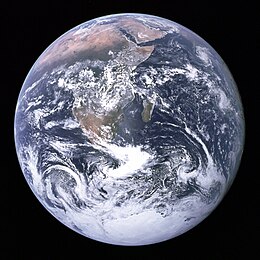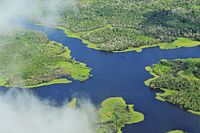
Back Gaia-hipotese Afrikaans فرضية غايا Arabic গাইয়া অনুসিদ্ধান্ত Bengali/Bangla Hipòtesi Gaia Catalan Teorie Gaia Czech Gaia-hypotese Danish Gaia-Hypothese German Θεωρία της Γαίας Greek Gaja hipotezo Esperanto Hipótesis Gaia Spanish

| Part of a series on |
| Rights of nature |
|---|
 |
| Movements and schools of thought |
| Traditional worldviews |
| Scholars and authors |
| Other |
The Gaia hypothesis (/ˈɡaɪ.ə/), also known as the Gaia theory, Gaia paradigm, or the Gaia principle, proposes that living organisms interact with their inorganic surroundings on Earth to form a synergistic and self-regulating, complex system that helps to maintain and perpetuate the conditions for life on the planet.
The Gaia hypothesis was formulated by the chemist James Lovelock[1] and co-developed by the microbiologist Lynn Margulis in the 1970s.[2] Following the suggestion by his neighbour, novelist William Golding, Lovelock named the hypothesis after Gaia, the primordial deity who personified the Earth in Greek mythology. In 2006, the Geological Society of London awarded Lovelock the Wollaston Medal in part for his work on the Gaia hypothesis.[3]
Topics related to the hypothesis include how the biosphere and the evolution of organisms affect the stability of global temperature, salinity of seawater, atmospheric oxygen levels, the maintenance of a hydrosphere of liquid water and other environmental variables that affect the habitability of Earth.
The Gaia hypothesis was initially criticized for being teleological and against the principles of natural selection, but later refinements aligned the Gaia hypothesis with ideas from fields such as Earth system science, biogeochemistry and systems ecology.[4][5][6] Even so, the Gaia hypothesis continues to attract criticism, and today many scientists consider it to be only weakly supported by, or at odds with, the available evidence.[7][8][9][10]
- ^ Cite error: The named reference
J1972was invoked but never defined (see the help page). - ^ Lovelock, J.E.; Margulis, L. (1974). "Atmospheric homeostasis by and for the biosphere: the gaia hypothesis". Tellus A. 26 (1–2): 2–10. Bibcode:1974Tell...26....2L. doi:10.3402/tellusa.v26i1-2.9731. S2CID 129803613.
- ^ "Wollaston Award Lovelock". Retrieved 19 October 2015.
- ^ Cite error: The named reference
Turney, Jon 2003was invoked but never defined (see the help page). - ^ Schwartzman, David (2002). Life, Temperature, and the Earth: The Self-Organizing Biosphere. Columbia University Press. ISBN 978-0-231-10213-1.
- ^ Gribbin, John (1990), "Hothouse earth: The greenhouse effect and Gaia" (Weidenfeld & Nicolson)
- ^ Kirchner, James W. (2002), "Toward a future for Gaia theory", Climatic Change, 52 (4): 391–408, doi:10.1023/a:1014237331082, S2CID 15776141
- ^ Volk, Tyler (2002), "The Gaia hypothesis: fact, theory, and wishful thinking", Climatic Change, 52 (4): 423–430, doi:10.1023/a:1014218227825, S2CID 32856540
- ^ Beerling, David (2007). The Emerald Planet: How plants changed Earth's history. Oxford: Oxford University Press. ISBN 978-0-19-280602-4.
- ^ Tyrrell, Toby (2013), On Gaia: A Critical Investigation of the Relationship between Life and Earth, Princeton: Princeton University Press, ISBN 9780691121581
© MMXXIII Rich X Search. We shall prevail. All rights reserved. Rich X Search